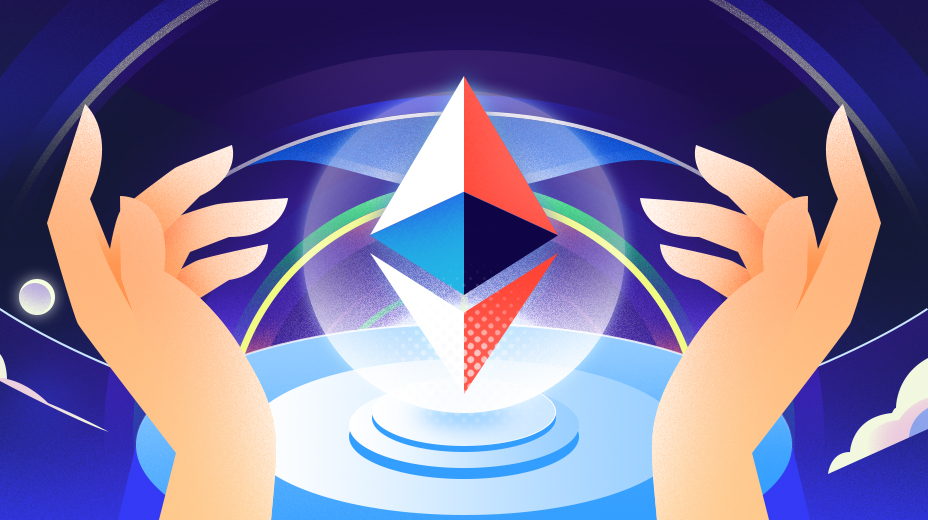Технологія Ethereum?
Тепер, коли ви ознайомилися з основами Ethereum, варто вивчити технологічні принципи, що лежать в основі Ethereum.

Смартконтракти
Смартконтракт — це договір, який реалізується програмним забезпеченням. На відміну від традиційного договору, де сторони звертаються до юридичної системи, смартконтракт самостійно забезпечує виконання (іноді — самостійно виконується), якщо виконуються певні умови, що контролюються програмою. На інфраструктурі Ethereum можна створити шар для підтримки смартконтрактів. Усі смартконтракти розробляють мовою програмування Solidity.
Смартконтракти мають такі переваги:
- Автоматично забезпечують рівноправність для всіх учасників.
- Захищають права особи, встановлюючи раціональні очікування для підписанта.
- Усувають ризик невиконання зобов’язань будь-яким із підписантів.
Приклад застосування смартконтракту:
Припустимо, Лаура і Майкл грають у “камінь, ножиці, папір”, а переможець трьох ігор виграє парі на 1 ETH. У цьому випадку смартконтракт може:
- Утримувати кошти обох гравців на ескроу-рахунку до визначення переможця.
- Гарантувати, що жоден гравець не знає вибір іншого до здійснення власного.
- Мати набір правил: камінь перемагає ножиці, папір перемагає камінь, ножиці перемагають папір.
- Вести облік перемог кожної гри до трьох перемог одного гравця.
- Виплатити всю суму фінальному переможцю трьох ігор.
Усе це реалізується об’єктивно, прозоро та без участі Лаури і Майкла.
Solidity
Solidity — статично типізована мова програмування із синтаксисом, подібним до JavaScript. Вона дозволяє програмістам створювати смартконтракти. Смартконтракти в блокчейні Ethereum пишуться у вигляді байткоду, який виконується у EVM.
Блокчейн Ethereum
Ethereum, як і Bitcoin, — це блокчейн, що дозволяє переказувати криптовалюти між особами без участі третьої сторони, наприклад банку чи міжнародної платіжної компанії. Розробники у світі створюють застосунки й платформи, які відкривають потенціал децентралізованої мережі Ethereum для широкої аудиторії. Формування екосистеми блокчейну потребує часу для повної інтеграції у світову економіку, але вже зараз багато організацій створюють застосунки, що взаємодіють із блокчейном Ethereum, відкриваючи нові способи створення та обміну цінністю.
Хвиля децентралізованих застосунків — dApps — змінює моделі у фінансах, музиці, іграх та соціальних медіа, демонструючи значні результати й просуваючи блокчейн-індустрію в епоху, де акцент на результатах, прийнятті й реальному покращенні життя користувачів. Деякі важливі проєкти:
- Metamask: вебплагін для підключення пристрою до мережі Ethereum.
- Brave: інтегрований веб- і мобільний браузер для BAT і ERC-20 токенів.
- Ethereum Name Service: платформа для створення індивідуальних і простих ETH-адрес гаманців.
- Decentraland: платформа віртуальної реальності для створення, дослідження й монетизації контенту та застосунків.
- Gnosis: ринок прогнозів і протокол DutchX для оцінки цифрових активів.
- CryptoKitties: відома гра, яка спричинила перевантаження мережі Ethereum, дозволяє створювати й обмінювати унікальних цифрових котиків.
Механізм консенсусу
Блокчейни потребують узгодження між учасниками мережі перед додаванням нового блоку. Для визначення легітимності транзакції використовується механізм консенсусу із застосуванням специфічного для мережі криптографічного методу валідації. Механізм консенсусу також вирішує конфлікти між конкуруючими записами, коли різні учасники пропонують різні транзакції щодо одного активу. Цей механізм забезпечує правильний порядок транзакцій і запобігає зловживанням з боку малоефективних учасників. Існує кілька типів механізмів консенсусу, але в Ethereum застосовують:
Proof of Stake (PoS) — схема, за якої власник монет отримує монети, підтверджуючи володіння певною кількістю монет, без необхідності розв’язувати складні математичні алгоритми (тобто майнити монети).
Віртуальна машина Ethereum (EVM)
Віртуальна машина Ethereum (EVM) — це безпечне й екологічне середовище виконання, у якому програмісти працюють дистанційно, завантажують поступові оновлення у блокчейн Ethereum, що сприяло появі численних децентралізованих застосунків (dApps). EVM — це розподілений комп’ютер у мережі, де коди та дані кожного контракту, тобто коди та змінні стану, розподіляються між усіма вузлами. Валідація нового блоку Ethereum оновлює всі змінні стану, включно з балансами всіх рахунків.
Висновок
Розуміння технології Ethereum є базовою передумовою. Більшість основних проєктів сьогодні натхненні ключовими технологіями Ethereum або створені для вирішення його обмежень. Знання, отримані у цьому модулі, стануть корисними під час вивчення інших проєктів.
Основні моменти
- Solidity — статично типізована мова програмування із синтаксисом, подібним до JavaScript, що дозволяє програмістам створювати смартконтракти.
- Ethereum — блокчейн для переказу криптовалют між особами без посередників.
- Механізм консенсусу Ethereum раніше базувався на Proof-of-Work (PoW), тому майнінг Ethereum був поширеним у криптосекторі. Після оновлення “The Merge” (розглядається далі), механізм консенсусу перейшов на Proof-of-Stake (PoS).
- Віртуальна машина Ethereum (EVM) — це середовище для завантаження поступових оновлень у блокчейн Ethereum, що сприяло появі численних децентралізованих застосунків (dApps).
Дотичні статті





